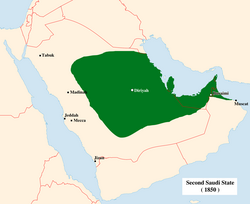
Back Emiraat Nadjd Afrikaans الدولة السعودية الثانية Arabic الدوله السعوديه التانيه ARZ Emiratu de Nechd AST Nəcd əmirliyi Azerbaijani নজদ আমিরাত Bengali/Bangla Druhý saúdský stát Czech Emirato de Néyed Spanish Najdeko Emirerria Basque امیرنشین نجد Persian
Second Saudi State | |||||||||||||
|---|---|---|---|---|---|---|---|---|---|---|---|---|---|
| 1824–1891 | |||||||||||||
 Borders of the Emirate of Nejd by 1850 | |||||||||||||
| Capital | Riyadh | ||||||||||||
| Common languages | Najdi Arabic | ||||||||||||
| Government | Absolute monarchy | ||||||||||||
| Imam | |||||||||||||
• 1819–1834 | Turki bin Abdullah (first) | ||||||||||||
• 1889–1891 | Abdul Rahman bin Faisal (last) | ||||||||||||
| History | |||||||||||||
| 1824 | |||||||||||||
• Battle of Mulayda with the Al Rashid | 24 January 1891 | ||||||||||||
| |||||||||||||
| Today part of | Saudi Arabia Qatar United Arab Emirates Oman | ||||||||||||
The Emirate of Nejd or Imamate of Nejd, also known as the second Saudi state was existing between 1824 and 1891 in Nejd,[1] the regions of Riyadh and Ha'il of what is now Saudi Arabia. Saudi rule was restored to central and eastern Arabia after the Emirate of Diriyah, the first Saudi state, having previously been brought down by the Ottoman Empire's Egypt Eyalet in the Ottoman–Wahhabi War (1811–1818).[2]
The second Saudi period was marked by less territorial expansion and less religious zeal, although the Saudi leaders continued to be called Imam and still employed Wahhabist religious scholars. Turki bin Abdullah bin Muhammad's reconquest of Riyadh from Egyptian forces in 1824 is generally regarded as the beginning of the Second Saudi State. Severe internal conflicts within the House of Saud eventually led to the dynasty's downfall at the Battle of Mulayda in 1891, between the forces loyal to the last Saudi imam, Abdul Rahman ibn Faisal ibn Turki, and the Rashidi dynasty of Ha'il.
- ^ Front Cover George Walter Prothero, Great Britain. Foreign Office. Historical Section. Peace Handbooks: Turkey in Asia (II), no. 61–66. H. M. Stationery Office, 1920. Pp. 20
- ^ Madawi al Rasheed (April 2010). A History of Saudi Arabia. Cambridge University Press. p. 25. ISBN 9780521761284. Retrieved 18 February 2017.

